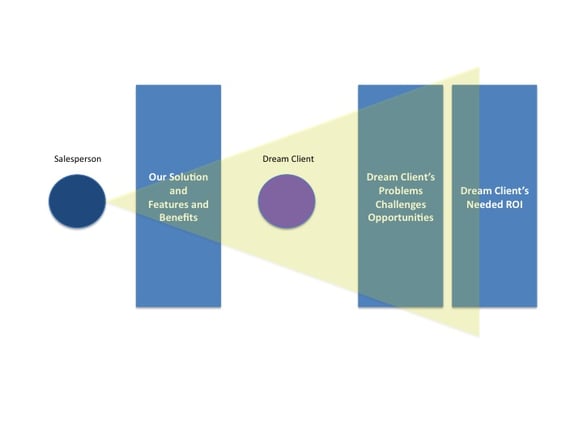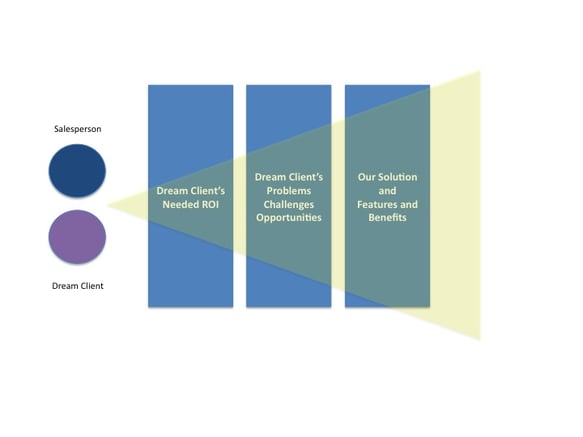Looking at Your Dream Client Through a Glass Darkly

June 8, 2010
You come to your dream clients carrying all of the ideas and experiences that you have had up to that point. In some cases, these ideas and experiences will assist you in properly diagnosing your dream client. In other cases, they will prevent you from doing so.
Sometimes you look at your dream client through the filter of your solution, viewing them with a bias towards cramming them into a solution that you have already created and sold in the past. This view distorts your perception of their problems, their challenges, and their opportunities. It creates problems in the diagnosis. It also clouds your view of their desired result or their return on investment.
Figure one is my not-so-elegant illustration of looking at your dream client through your own solution.
The salesperson is looking at their dream client through their own solution, with all of its features and benefits. By doing so, they are not looking at their dream client’s problems, challenges and opportunities directly, but are sitting across the table capturing only what the client says that fits inside the bias of his solution. The dream client’s needed improvement or return on investment is too far away to make out through these filters.
Figure two is also my not-so-elegant illustration, this time of a better way (both metaphorically and literally) of diagnosing your dream client’s organization.
In this illustration, the salesperson is sitting on the same side of the table as their dream client. Sitting on the same side of the table viewing the needed outcome creates a resourceful, collaborative conversation that gives us a better view and helps us to obtain all of the ways the needed outcome might be achieved.
Instead of looking through the salesperson’s bias towards their existing solution first, they are both looking at the dream client’s needed outcome. The problems, challenges, and opportunities that the dream client faces are viewed through the lens of the needed outcome. Finally, the solution that we will later propose will be viewed through the outcome, and the problems, challenges, and opportunities that need to be dealt with in order to produce that outcome. The proposal will be the product of their combined view of the needed outcome, the problems and opportunities, and the solution, increasing the likelihood of winning.
For most of us the idea of diagnosing before prescribing isn’t a new one. But the idea of changing the order and removing our desire to diagnose without filtering everything we see, hear, and feel through our existing solutions is, if not a new idea, one that we could execute a whole lot better.
It is sometimes hard to remember that it isn’t your solution that wins the deal. It is the outcome that your solution produces in the way of better results and return on investment that wins the deal.
Conclusion
We often come to our clients carrying a bias towards our existing solutions that prevent us from getting a full and complete view of the outcome they need. A better way to diagnose your dream client’s organization is to remove the filters your solutions create and view their needed outcomes from their side of the table, using their outcomes as the filter through which to view our solutions.
Questions
-
- Be honest, do you know what you are going to prescribe before you even sit down in your dream client’s office?
-
- Does your needs analysis and diagnosis probe for problems and issues for which you know you already have a solution? Could that be preventing you from selling the outcome? Could not selling the outcome be costing you deals?
-
- How could you remove your existing biases towards your solution and work towards gaining a fuller understanding of what your dream client really needs?
- Do you ever believe that your solution is superior? Does it matter if your dream client believes that your competitor can help them to achieve a better outcome?
For more on increasing your sales effectiveness, subscribe to the RSS Feed for The Sales Blog and my Email Newsletter. Follow me on Twitter, connect to me on LinkedIn, or friend me on Facebook. If I can help you or your sales organization, check out my coaching and consulting firm, B2B Sales Coach & Consultancy, email me, or call me at (614) 212-4279.
Read my interview with Tom Peters (Part One and Part Two).
Read my Blogs.com featured guest post on the Top Ten Sales blogs.
Read my monthly post on Sales Bloggers Union.
Get The Sales Blog iPhone App to read The Sales Blog and Twitter Feed on your iPhone.









.jpg?width=768&height=994&name=salescall-planner-ebook-v3-1-cover%20(1).jpg)


